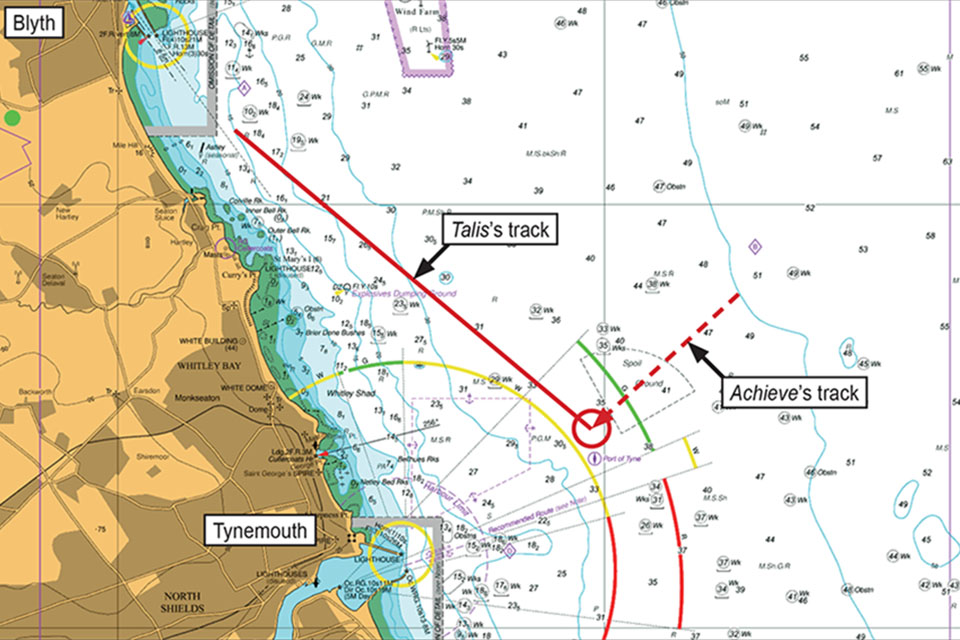Safety flyer to the fishing industry - Achieve and Talis
Published 3 December 2021
1. Summary
Collision between fishing vessel Achieve (HL257) and general cargo ship Talis, resulting in the sinking of Achieve off Tynemouth, England, on 8 November 2020

Image courtesy of RNLI (Tynemouth)

Image courtesy of Paul Gowen (www.shipspotting.com)
2. Narrative
On 8 November 2020, the 9m wooden prawn trawler Achieve collided with the 82m general cargo ship Talis in fog. Achieve was severely damaged and sank while being towed to port.
Achieve had completed fishing and was heading back to Tynemouth to land its catch. It was on a south-westerly course at 5 knots. The skipper was in the wheelhouse and spent some time familarising himself with a new radar, which he had fitted two days previously. The deckhand was working in the aft shelter deck, sorting the catch. At some point, the skipper went aft to check on the deckhand’s progress with boxing the prawns.

Chart showing tracks of Talis and Achieve (reproduced from Admiralty Chart 156 by permission of HMSO and the UK Hydrographic Office)
Talis was on passage between Blyth and the Netherlands on a south-easterly course at 8 knots. The bridge was manned by the chief officer and an able seaman as lookout. During the passage, the chief officer worked at the chart table and ship’s computer.
Achieve was less than a mile away when Talis’s chief officer spotted a target on the radar about 30º on the port bow. With the able seaman he looked out from the port side of the bridge and suddenly spotted Achieve very close; he could see there was no-one in the wheelhouse. He sounded the whistle then altered course to starboard, but it was too late to prevent the collision.
3. Safety Lessons
-
Keeping a proper lookout is fundamental to safe navigation. In fog, different methods are required, which are usually focused on the radar and, if fitted, Automatic Identification System (AIS). A proper lookout was not being kept on either vessel, and prior to the collision the skipper of Achieve was not in the wheelhouse.
-
Achieve was not fitted with either a radar reflector or AIS, both of which would have made the fishing boat more visible. However, once Talis’s watchkeeper had seen Achieve on the radar, he lost valuable time assessing the contact rather than taking early action to avoid the collision.
-
Neither vessel was sounding fog signals. With the use of radar and AIS it is tempting to assume that vessels will detect each other long before a fog signal is heard. However, when all else fails, hearing a fog signal can give a valuable warning of danger.
Our accident investigation report is available at: https://www.gov.uk/maib-reports/collision-between-prawn-trawler-achieve-and-general-cargo-vessel-talis-and-subsequent-sinking-of-achieve.
Extract from The United Kingdom Merchant Shipping (Accident Reporting and Investigation) Regulations 2012 – Regulation 5:
The sole objective of the investigation of an accident under the Merchant Shipping (Accident Reporting and Investigation) Regulations 2012 shall be the prevention of future accidents through the ascertainment of its causes and circumstances. It shall not be the purpose of an such investigation to determine liability nor, except so far as is necessary to achieve its objective, to apportion blame.
Note:
This safety flyer is not written with litigation in mind and, pursuant to Regulation 14(14) of the Merchant Shipping (Accident Reporting and Investigation) Regulations 2012, shall be inadmissible in any judicial proceedings whose purpose, or one of whose purposes is to attribute or apportion liability or blame.
Marine Accident Investigation Branch
First Floor, Spring Place
105 Commercial Road
Southampton
SO15 1GH
Email iso@maib.gov.uk
Enquiries during office hours +44 (0)23 8039 5500

